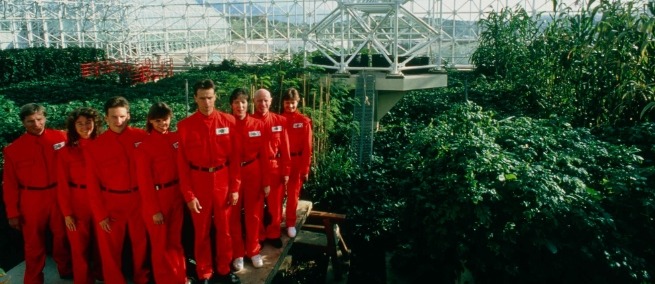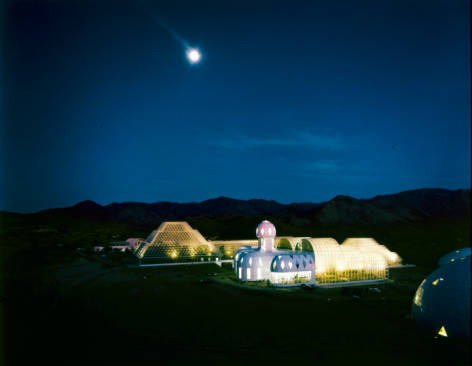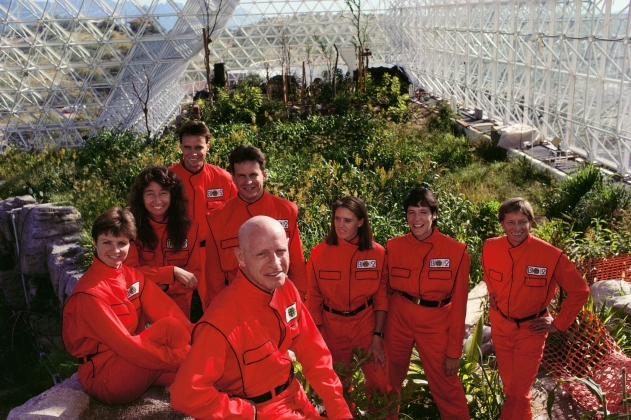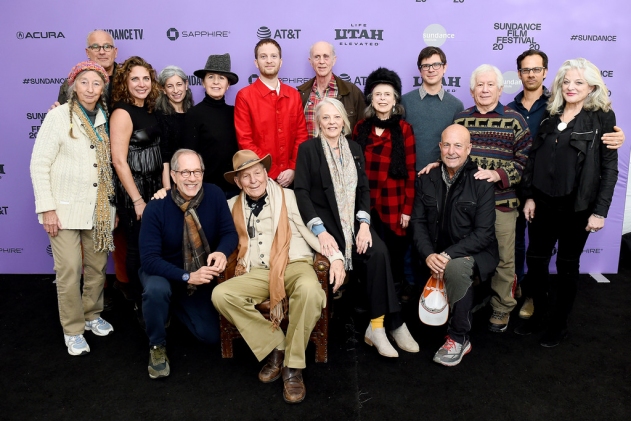
SPACESHIP EARTH is an astonishing film about the experimental, visionary, and wildly ambitious group of individuals whose collective endeavors included sealing eight men and women in Biosphere 2, a closed system environment meant to model what sustainable living would look like on Earth and on other planets. Directed and produced by Matt Wolf (TEENAGE), the film intermixes never-before-seen archival footage with present-day interviews with the individuals who were part of the Biosphere 2 project in the early 1990s, as well as those who participated in the Theater of All Possibilities’ projects leading up to Biosphere 2 beginning in the late 1960s. The Theater’s ethos was “learning by doing.” In addition to Biosphere 2, the group started a functioning ranch called Synergia Ranch in New Mexico, sailed around the world in a ship of their own making, gave workshops, and were very involved in actions related to mitigating climate change.
At the film’s world premiere at Sundance, we sat down with director Matt Wolf to learn more about the processes and ideas that went into the making of SPACESHIP EARTH. Neon has just acquired the film’s worldwide distribution rights.
Science & Film: How did you first hear about Biosphere 2?
Matt Wolf: I do a lot of Internet research to find film ideas, and I saw these images of people in red jumpsuits in front of a glass pyramid. I actually assumed they were stills from a science fiction film. Then I realized that it was real and as soon as I did, I was very determined to connect with these people and to hopefully tell their story. A couple of months later my producer, Stacey Reiss, and I went to Synergia Ranch.
S&F: Was it difficult to get access?
MW: Yeah, it was. They have been burned a lot by the media. I always say to people, you can’t just expect trust, it has to be earned, and part of going to the ranch was to build that relationship. We were brought into this temperature-controlled room and it had hundreds of 16mm films, photographs, and slides, and Betamax tapes. It was astonishing. It’s kind of the dream of a documentary filmmaker. It was significant because they [had] recognized that what they were doing was historic, but the rest of the world didn’t. Their major project was rebuked in the media. To encounter a group of people who are so interesting, whose work has a kind of enhanced urgency in our current moment, and to have had them document their half a century of activity, and for it to be untapped—I mean, it’s been thrilling.

Biosphere 2, Oracle, Arizona, 1991. Photo by Wayne Thom, (c) University of Southern California Libraries.
S&F: It’s a thrilling movie to watch, I have to say. By the time Steve Bannon is appointed CEO, I literally think I said out loud at the screening what the fuck?!
MW: That wasn’t even what attracted me to it. It was really just understanding that this was a group that weren’t hippies, they weren’t businesspeople: they were at this weird intersection of counterculture and enterprise. They recognized climate change at a very early period and were imagining space colonization. Those things are obviously so tangible now, in that they’re being pursued by private enterprise. So many of the things they were doing have a lot of contemporary resonance, and I’m drawn to stories where individuals pursue projects that are discounted or misunderstood. Trying to reappraise those in our current moment to really ask the question: so, what, and why now? With them, it became clear right away that it [their story] really matters right now.
S&F: Yes. Related to space travel, there is always the Carl Sagan argument of the pale blue dot–that seeing Earth from outer space you realize that we’re all one. But in practice, thinking about the way that a closed system can operate, which has to be sustainable, is a model of how research into space travel can directly address environmental concerns.
MW: If one were to live in a closed system in which every action taken, including a breath, had consequences, and you could measure those consequences and see them and modify your behavior to create balance and sustainability in your world...I mean, that’s a transformative experience, and it’s difficult for us to feel a sense of consequence for our actions here, but in this simulation of the planet you could see the results of your actions.
S&F: Do you have any sense of what happened to the climate change movement?
MW: I think they had a very contemporary idea–one could call it a neoliberal model–that a real, sustainable business model could merge with sustainable ecology, and that it would not only be informative about living here on Earth, but also could create a model of future if we do face ecological catastrophe. At the end of the day, that model of commerce intersecting with environmentalism didn’t succeed because the project they envisioned was designed to be 100 years, and the viability of maintaining that became impossible when the project was subject to withering criticism.

Courtesy of Sundance Institute
S&F: Even people today don’t all understand why the project was named Biosphere 2. People still think that there is a Biosphere 1.
MW: The concept was, by calling it Biosphere 2, people would say well, what is Biosphere 1?, and Biosphere 1 is planet Earth. I love that there was a sign at the Biospherians’ reentry ceremony that said, “Welcome back to Biosphere 1.” We only found that clip toward the end of the process.
S&F: What was the collection of footage like that you ultimately used in the film? Did you digitize the whole collection?
MW: We had a team that indexed the entire collection–this is typical of how I work. They indexed the entire collection and catalogued all of the metadata that existed on the film canisters or tapes, and I actually pulled selects from the 2,000 photographs. And then they had a scene back at the ranch at the barn, and we had a 16mm specialist from New Mexico who made DVD copies of the preview screen. We edited with that, and then we selected high-priority stuff from the analog tapes and had that transferred. We had 2,000 photographs that we were working with and 600 hours of footage, but it was meticulously logged. And then we had a team who was organizing all of that by topic, and period, and pulling greatest hits for us. I like creating a unique process for really archive-heavy films to manage the unmanageable. But they really had done a good job tracking their entire history. And the Biosphereian Roy Wallford had filmed everything inside. He had also accumulated tons of material because he had intended to make his own documentary.
S&F: Why didn’t he?
MW: He died prematurely, of Lou Gehrig’s disease, and at the end of his life he was really focused on making this film. He made a film, it wasn’t released, but he was determined to I think make sense of his experience inside Biosphere 2 by reflecting on this material he had collected. It was also a form of data.
S&F: Is there anything that you’ve read that has been particularly informative about the time in which this project took off, so to speak?
MW: I’ve been inspired for a long time by Fred Turner’s book Counterculture To Cyberculture. It’s a cultural history through the lens of Stewart Brand, who founded the Whole Earth Catalog and Wired Magazine, and it reveals this history of people who went back to the land in the 60’s, and how they had an early interest in technology. A lot of the counter-cultural movement evolved into the startup/dot com culture. I think that is really emblematic of this story. John Allen in particular, he is a proto-startup cult of personality guru. Their whole model was based on a disruption of conventional science and space research.
S&F: Without a profit model.
MW: With an investor who was willing to think very long term. Which is unusual, and which didn’t pan out. I’m interested only in stories of the 60s if they really divert from your expectations of hippies, and they were not hippies. They even rejected the notion that Synergia Ranch was a commune.
S&F: What did they prefer?
MW: They called it a ranch, and they were reticent to call it a commune because they thought communes were rife with drugs and burnouts. They were these workaholics who were starting business enterprises, you know? They were capitalistic.
S&F: Also very DIY. Like when you see them building this ship. How the hell did they learn how to do that?
MW: I think that was another inspirational aspect, this learning by doing ethos, and the level of ambition. A lot of idealists discourse, but it always manifests in projects for them, and those projects were actualized in really thorough, rigorous, and comprehensive ways. It’s really inspiring that Biosphere 2 was the product of decades of field work and learning by doing, and that they did indeed collaborate with more experienced ecologists and scientists to dream up this conceptual idea. I think it’s a very unusual model for a group to do projects and work together.
I’m drawn towards the fact that they were artists as well. As I’m starting to discuss the film, it’s really this, on a basic level, group of people who literally reimagine the world. And this is a sentiment that we need to think about now: reimagining the world. But, to literally do it, what are the consequences of that? What are the possibilities? What are the limitations? And they grappled with that in a way that was flawed, but also visionary.
S&F: Beautifully said. It felt very inspiring to watch.
MW: Thank you. It surprised me how inspiring the film was by the end. When I saw the raw footage of the Heraclitus [the ship] I was crying. I try to be very emotionally available when I look at raw material and interview people. To imagine the sense of accomplishment and achievement in making this thing and having it work. There’s this montage in the film, this huge orchestral moment with beta-cam footage of the whole structure being built, and the time lapse of it going up, and I get very emotional watching it. Humans can do incredible things if they have the determination, ambition, and focus, and in this case, collaboration. And if people said that as a theme, I would think: “that sounds kind of general and wishy-washy,” but, through the specificity of the things they did, which are so hard to understand unless they are pieced together into a coherent narrative, it was really inspiring. And ultimately, the fact that they’ve stayed together, that’s another thing that I expect will be a surprise to people.
S&F: In the film, there is someone interviewed who at the time predicted all the people in Biosphere 2 would turn against each other. But ultimately that isn’t the problem.
MW: Part of the process of failing is that you learn. And failure is in fact one of the most instructive things that can happen in a bold experiment against nature. I think the fantasy was that it would become this LORD OF THE FLIES reality TV show, and that’s what happens when you take on the world stage. When you bring this element of theatricality to the media, it stokes a kind of popular fantasy that may undermine the fundamental goals and ideas behind the project.
I think the takeaway is also: small groups are engines of change. That was an idea that came into focus at the end. It’s kind of about everything, but that is a really specific thing it’s about. And looking at the end of the film, it’s kind of like if you have to reimagine the world, are we going to get consensus among everybody about how that is to be done? No. Thinking on the scale of small groups to achieve new ideas or to achieve tangible projects is viable. As Linda Leigh, the Biosphereian says, she learned that you can’t do it by yourself. And it’s very inspiring to think about the imprint you might have on the world, and a potential model in which you don’t have to accomplish that alone.
S&F: Art movements can be sort of similar. I’m reading a book right now called Ninth Street Women about all of the artists who were in the same place at the same time who were trying to change something about the way that they approached canvases. It was one by one, and then it got seen, and then it became a movement that changed the history of art.
MW: Totally. I’m trying to think of other examples...I think a kind of truism of environmentalism that people take for granted is the idea of localism and eating the food that you grow. Linda is that. She lives in Oracle, the town where Biosphere 2 is, and she is building a community garden. She walks out of this little, tiny, green house. I mean, she operates on such a local level, but I think an accumulation of different approaches modeled through small groups is an achievable way to reimagine the world if you don’t have the resources and determination to rebuild a completely new one.
S&F: What do you think about the science community calling the Biosphere 2 project invalid as an experiment?
MW: I think of the word “experiment” as it relates to this project, and I expect a lot of people will want to get into the weeds, and ask really technical questions about Biosphere 2, but it wasn’t my goal to really get granular on that. But Kathleen, who features prominently in the film, refers to what they did as a lifetime experiment, and I found that to be a really compelling idea. And, Linda Leigh said to me, something that wasn’t in the film, that one of the mistakes we made to it maybe was referring to it as an experiment. People have expectations and associations with what an experiment actually is. That’s hypothesis-driven, small scale science. Reproducible. And they were experimental people. There was an aspect of this that was a human experiment. This group engaged in a lifetime experiment. It was an experimental approach to science. But, to call it an experiment was part of the miscommunication about the intentions as well.
Utopia hasn’t come up that much in the conversation, and I don’t think Biosphere 2 is meant to be a utopia in any way. I think it was a model for the future in terms of how people might live responsibly on Earth, and what we might have to live like in the future if we don’t act responsibly. I think they proved that people can build and live inside closed ecological systems that can support human life. Did it do that perfectly in this scenario? No, but they learned. And what they learned can tell us a lot more about how to make that system work better and better, but it also would be information that can inform how we understand the atmospheric dynamics on Earth.

Matt Wolf (in the red jacket) with cast and crew of SPACESHIP EARTH at the 2020 Sundance Film Festival.
SPACESHIP EARTH made its world premiere Sundance 2020’s U.S. Documentary Competition. It will be distributed by Neon. SPACESHIP EARTH was directed and produced by Matt Wolf, produced by Stacey Reiss, edited by David Teague, and features music composed by Owen Pallett. Wolf’s other recent work includes Some of Matt’s other recent works include WILD COMBINATION, about the musician and composer Arthur Russell; TEENAGE, about youth culture; and RECORDER, about the activist Marion Stokes.
TOPICS